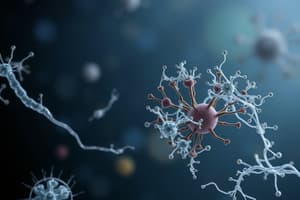Podcast
Questions and Answers
Which of the following is NOT a characteristic of a virus?
Which of the following is NOT a characteristic of a virus?
- They contain nucleic acid.
- They lack a protein coat. (correct)
- They are visible only with electron microscopy.
- They are non-cellular.
If a bacterium is in a vegetative form, what is its metabolic state?
If a bacterium is in a vegetative form, what is its metabolic state?
- Dormant and inactive
- Resistant to environmental changes
- In a state of sporulation
- Actively growing and multiplying (correct)
Which of the following is NOT a branch of study within Microbiology?
Which of the following is NOT a branch of study within Microbiology?
- Resistant to environmental changes
- Actively growing and multiplying (correct)
- In a state of sporulation
- Dormant and inactive
Which type of microorganism is characterized by having a primitive nucleus?
Which type of microorganism is characterized by having a primitive nucleus?
What is the role of endospores in the bacterial life cycle?
What is the role of endospores in the bacterial life cycle?
Which of the following microorganisms is NOT considered a cellular organism?
Which of the following microorganisms is NOT considered a cellular organism?
What is the primary difference between a virus and a viroid?
What is the primary difference between a virus and a viroid?
Which of the following is NOT a characteristic of Archaea?
Which of the following is NOT a characteristic of Archaea?
Which of the following is a true statement regarding the classification of microorganisms?
Which of the following is a true statement regarding the classification of microorganisms?
Flashcards
Microbiology
Microbiology
The study of organisms too small to see without magnification.
Types of Microorganisms
Types of Microorganisms
Includes Bacteria, Viruses, Fungi, Protozoa, Helminths, Algae, and Prions.
Prokaryotes
Prokaryotes
Organisms without a true nucleus; includes Archaea and Bacteria.
Eukaryotes
Eukaryotes
Signup and view all the flashcards
Taxonomy
Taxonomy
Signup and view all the flashcards
Viruses
Viruses
Signup and view all the flashcards
Sporulation
Sporulation
Signup and view all the flashcards
Germination
Germination
Signup and view all the flashcards
Bioremediation
Bioremediation
Signup and view all the flashcards
Prions
Prions
Signup and view all the flashcards
Study Notes
Microbiology Overview
- Microbiology is the study of organisms too small to be seen without magnification.
- Microorganisms include Bacteria, Viruses, Fungi, Protozoa, Helminths, Algae, and Prions.
- Microscopes were essential in the development of microbiology.
- Branches of microbiology include Immunology, Public health microbiology and epidemiology, Food, dairy and aquatic microbiology, Biotechnology, and Genetic engineering and recombinant DNA technology.
- Microbiology involves manipulating genes.
Microbial Roles and Applications
- Microbes are important in nutrient production, energy flow, decomposition, and food/drug/vaccine production.
- Biotechnology utilizes microbes for various applications, genetic engineering, and bioremediation.
- Microbes cause infectious diseases.
Microbial Classification
- Microorganisms are classified into cellular and non-cellular categories.
- Cellular microorganisms can be prokaryotic (lacking a true nucleus) or eukaryotic (possessing a true nucleus)
- Prokaryotes: Include bacteria, archaea, and blue-green algae.
- Eukaryotes: Include algae (excluding blue-green algae), fungi, and protozoa.
- Non-cellular microorganisms: Include viruses, viroids, and prions.
Taxonomic Groups
- Bacteria: Prokaryotic, unicellular organisms.
- Archaea: Prokaryotic, unicellular organisms inhabiting extreme environments.
- Algae: Eukaryotic organisms, performing photosynthesis.
- Fungi: Eukaryotic, could be unicellular or multicellular.
- Protozoa: Eukaryotic, unicellular organisms.
- Viruses: Non-cellular, seen only through electron microscopy, composed of nucleic acid and protein coat.
- Viroids: Non-cellular, plant pathogens composed of RNA, cannot produce proteins.
- Virusoids: Similar to viroids, primarily plant pathogens.
- Prions: Non-cellular, infectious proteins.
Bacterial Life Cycle
- Bacteria exist primarily in the vegetative form—a metabolically active, growing, multiplying, and infectious phase.
- Under unfavorable environmental conditions, bacteria can form endospores.
- Spores are a dormant, highly resistant resting phase.
- Under favorable conditions, spores revert to the vegetative form through germination.
Studying That Suits You
Use AI to generate personalized quizzes and flashcards to suit your learning preferences.




